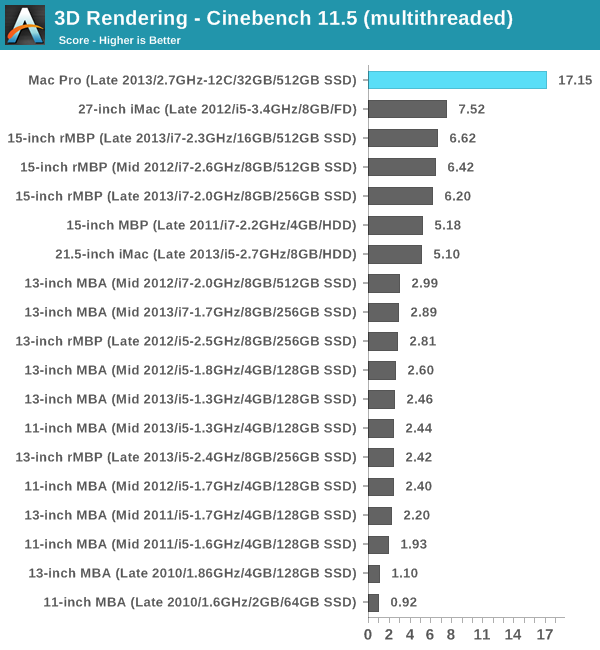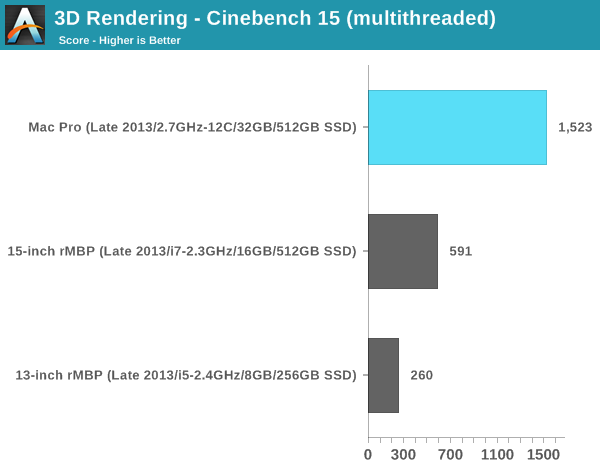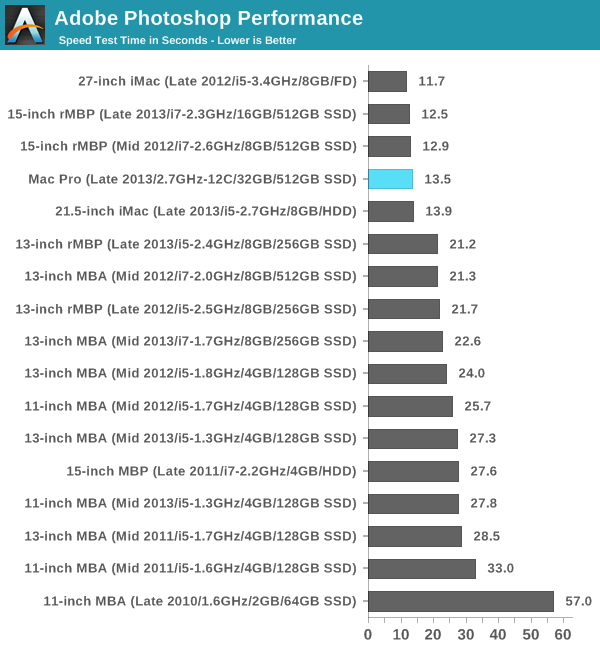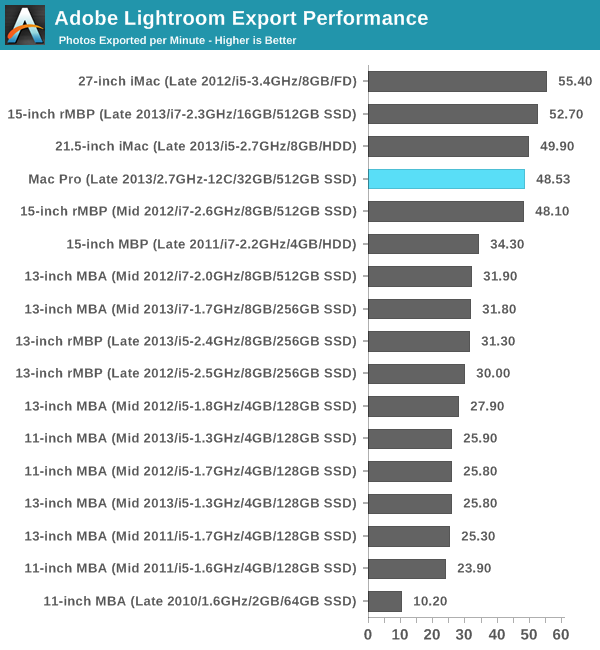The Mac Pro Review (Late 2013)
by Anand Lal Shimpi on December 31, 2013 3:18 PM ESTMac Pro vs. Consumer Macs
For my final set of CPU performance charts I put the new Mac Pro through the same set of tests I do all new Macs. There are definitely multithreaded components to these tests (some are indeed highly threaded), but the suite also values good single threaded performance. Here we'll get an idea of how the new Mac Pro, in its most expensive configuration, fares as a normal Mac.
I've already gone through Cinebench 11.5 results, but the following graphs should put in perspective the Mac Pro's performance relative to all consumer Macs:

If there's one graph that tells the story of why Intel's workstation roadmap is ridiculous, it's this one. The Mac Pro follows Intel's workstation roadmap, which ends up being cut down versions of Intel's server silicon, which happens to be a generation behind what you can get on the desktop. So while the latest iMac and MacBook Pro ship with Intel's latest Haswell cores, the Mac Pro uses what those machines had a year ago: Ivy Bridge. Granted everything else around the CPU cores is beefed up (there's more cache, many more PCIe lanes, etc...), but single threaded performance does suffer as a result.
Now part of this is exaggerated by the fact that I'm reviewing the 2.7GHz 12-core Mac Pro configuration. Single core turbo tops out at 3.5GHz vs. 3.9GHz for the rest of the parts. I suspect if you had one of the 8-core models you'd see peak single threaded performance similar to what the 2012 27-inch iMac delivers. The 2013 27-inch iMac with its fastest CPU should still be quicker though. We're not talking about huge margins of victory here, a matter of a handful of percent, but as a much more expensive machine it's frustrating to not see huge performance leadership in all areas.
The Mac Pro is designed to offer competitive single threaded performance, but really deliver for everyone who depends on great multithreaded performance:

If you need more cores, the Mac Pro is literally the only solution Apple offers that can deliver. We're talking about multiple times the performance offered by anything else in Apple's lineup with a Pro suffix.
I'm slowly but surely amassing Cinebench 15 results. The story doesn't really change here, I just thought I'd publish the numbers in case anyone wants data using this new test:


The latest versions of iPhoto and iMovie break comparisons to my older benchmarks so I've had to drop them here. I still have our Photoshop CS5 and Lightroom 3 tests though:

As I mentioned earlier, threading seems to have improved on newer versions of Photoshop. In CS5 our benchmark looks more like a lightly threaded test by comparison. Out of curiosity I ran the test under Photoshop CS6 and came away with a completion time of around 6 seconds.

Our Lightroom 3 export test tells a very similar story. Anyone with lighter workloads looking for a huge performance increase thanks to the Mac Pro will have to look elsewhere. The Mac Pro is at least performance competitive, but in these lightly threaded workloads you won't see a huge uplift.










267 Comments
View All Comments
akdj - Wednesday, January 1, 2014 - link
This is what you gleaned from such an insightful review....of a revolutionized desktop computer from Apple? Seriously? He was running a GPU and CPU 'poison' in order to find the ceiling. NOTHING in his real world testing including editing, rendering and transcoding 4k video increased core temps dangerously, nor did they spin the fans up audibly (a quiet room is typically 40-45dB). Wow. Amazing comprehension. Guess it fits with your 'name'Morawka - Wednesday, January 1, 2014 - link
the very next paragraph he reached the same power use and same thermal throtteling using a "normal 4k workload", he just didnt go back and correct his first paragraph about it not being able to hit that ceiling on normal workloads.damianrobertjones - Thursday, January 2, 2014 - link
"of a revolutionized desktop "Oh please stop. It's just a desktop with x or y and nothing amazingly special.
akdj - Friday, January 3, 2014 - link
"It's just a desktop with x or y and nothing amazingly special."....lol. Are you 16? I'm 43....and THIS is a revolution in desktop technology, power, size, speed, aesthetics, storage, expandability and power efficiency. 'X' and 'Y' are pretty F'ing 'significant' IMHO. Oh....yeah....it's Rev A. A baby. As a user of ridiculously large boxes, servers and heavy monitors over the years----to call it anything BUT revolutionary is ignorant. Revolutionary doesn't always have to equal success immediately---but with the decline in desktop sales...but still the 'need' to have desktop power, it's pretty cool someone thought outside of the 'box'tyaty1 - Wednesday, April 1, 2015 - link
While the design is intuitive, any kind throttling is unforgivable in this price range. The old Mac Pro did not do that, even a skillfully home-built desktop computer wont to that either.It is not desktop computer , but a workstation. It needs to serve its purpose without fault, no more no less.
Apple stepped into the consumer line too much, and it works them well, but it negatively impacts the business/professional customers.
Morawka - Wednesday, January 1, 2014 - link
hell i dont think the cooler surface area is a problem, i think the Black Chassis, Black Cooler, Black PCB are all whats causing the high temps. they should have left the thermal core pure copper and not used any anodizing. Black keeps heat in!name99 - Wednesday, January 1, 2014 - link
I guess you're unfamiliar with the concept of black body radiation...jasonelmore - Thursday, January 2, 2014 - link
i am, but reading the wiki on "black body radiation" i fail to see how it applies to this Mac Pro.wallysb01 - Friday, January 3, 2014 - link
Things colored black radiate (and absorb) heat faster than other colors. Black body radiation has nothing to do with things actually being black.Ppietra - Friday, January 3, 2014 - link
black body radiation refers to the kind of radiation that a body emits due to its temperature.Most thermal radiation (at this kind of temperatures) is infrared, so it doesn’t matter what is the visible color of the objects surrounding the "hot" object.
But even if the "hot" body emitted significant visible light, the black color of the surrounding objects would actually help absorb that energy which would then be dissipated as infrared radiation or by heat transfer to the air or other objects